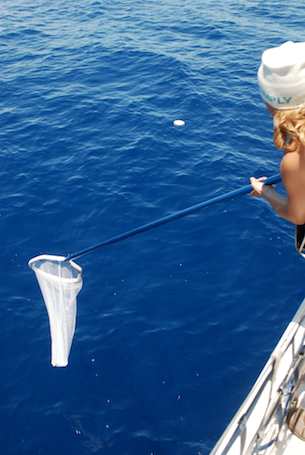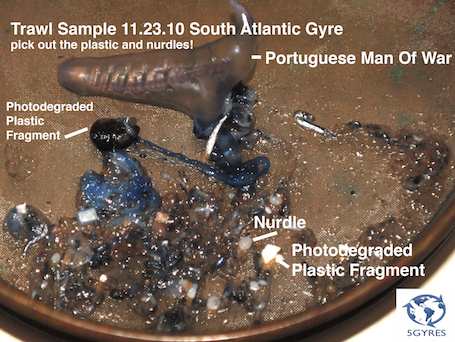
(Anna Cummins of The 5 Gyres Institute picks out a larger piece of plastic from the ocean. All the small specs of white are micro-fragmented plastic some 2,000 miles out to sea. image credit: Stiv Wilson/5gyres.org)
As the world is slowly waking up to its single-use plastic addiction, researchers are showing that oceanic plastic pollution isn't just a North Pacific Gyre and a North Atlantic Gyre problem. No, recent research shows that there are several more areas in the sea that accumulate plastic waste from land.
The Garbage Patch, as it's so called, isn't a patch at all, but rather a very diffuse area of plastic pollution that manifests more like a plastic soup, rather than some mythical Texas-sized island. Plastic isn't simply relegated to the gyres though. A gyre, formed by a combination of dominant wind patterns and the earth's rotation, simply concentrates it, acting like a toilet bowl without a flush. Plastic is everywhere in the ocean, and rarely (very- perhaps less than 1% of the time) does a surface sample come up totally clean even outside the conjectured borders of the gyres. Plastic in the ocean doesn't seem to vary in frequency, but rather in density.
To date, there have only been a couple dozen expeditions to sample the ocean's surface for plastic. "We just need a lot more data," said, Kara Lavendar Law, of SEA Education Association last week at The 5th International Marine Debris Conference in Hawaii. Law's group has the most data of any research group out there, having compiled and published some 20+ years of sampling in The North Atlantic. But gathering more data is expensive. Typical research missions cost about $26,000 US a day, something the 5 Gyres Institute model aims to solve. The 5 Gyres team sails a highly efficient 72 foot cutter, and has decreased the cost of at sea plastic density data collection to around $2,000 a day. The groups hopes is to create a global distribution baseline that will give scientists, policymakers and concerned citizens alike a better view of the issue as it truly reveals itself in the ocean.
How Much Is Out There?
Attempting to answer just how much plastic is out in the ocean is notoriously difficult. But when you're talking about 315 million square kilometers of ocean surface covering 70% of the earth, and estimated 10-100 pounds of plastic per kilometer the amount tends add up quickly. Lavendar Law's data from the North Atlantic suggests that density hasn't increased over the past 20 years, but she's quick to say that this doesn't necessarily mean plastic in the ocean isn't increasing. Given population increase, insignificant worldwide recycling rates and skyrocketing consumption of disposable plastic, Law poses the question, "Where is it going?" Plastic doesn't biodegrade, but sunlight breaks it into smaller and smaller particles. Some researchers believe it might be sinking. Fouled by marine organisms, the actual buoyancy of plastic might be changing by being colonized or it might compress and change buoyancy when driven down into the water column by heavy seas. To date, no significant expedition to explore for plastic pollution on the ocean floor has ever taken place.
To get an idea of distribution, imagine sailing 8,000 miles (just under half the earth's circumference at the equator) for some 70 days out of sight of land and finding plastic particles in every sample. That's cosmic math, especially when you add to the equation that we as a society have only been using this stuff in earnest for about 40 years.
The Southern Hemisphere
Below the equator the ocean boasts three other gyres and it's been the mission of the non-profit, 5 Gyres.org to document them all. Built on the idea that a global problem requires a global solution, The 5 Gyres Institute takes artists, filmmakers, students, teachers, photographers, journalists, pro surfers-- stakeholders from all over the world looking to understand this problem firsthand.
The South Atlantic Gyre
The 5 Gyres team, (of which I serve as crew) just completed two successful crossings of the South Atlantic late last year and early this one, from South America to Africa and back, to find what we were afraid we would: plastic-- micro-fragments and macro-pollution such as buckets, laundry baskets, plungers, water bottles, plastic sheeting and large polypropylene fishing nets. 
(image: Stiv Wilson/5gyres.org)
The South Pacific
Currently, the position of the 5 Gyres team is on the outer fringe of an uncharted gyre, The South Pacific, a never before area studied for plastic pollution. The ship will sample from international waters off Valdevia, Chile, to Easter Island and then onto Tahiti. Preliminary reports suggest the surface samples are less dense than comparable samples from other gyres, but based on electronic drift buoy modeling of where the densest accumulation zone should be, it looks to be one of the tightest gyres in the world. The ship's position is still some 600 nautical miles from the center, sailing towards the eye. Time will tell what pollution exists there. Let's hope it's less.